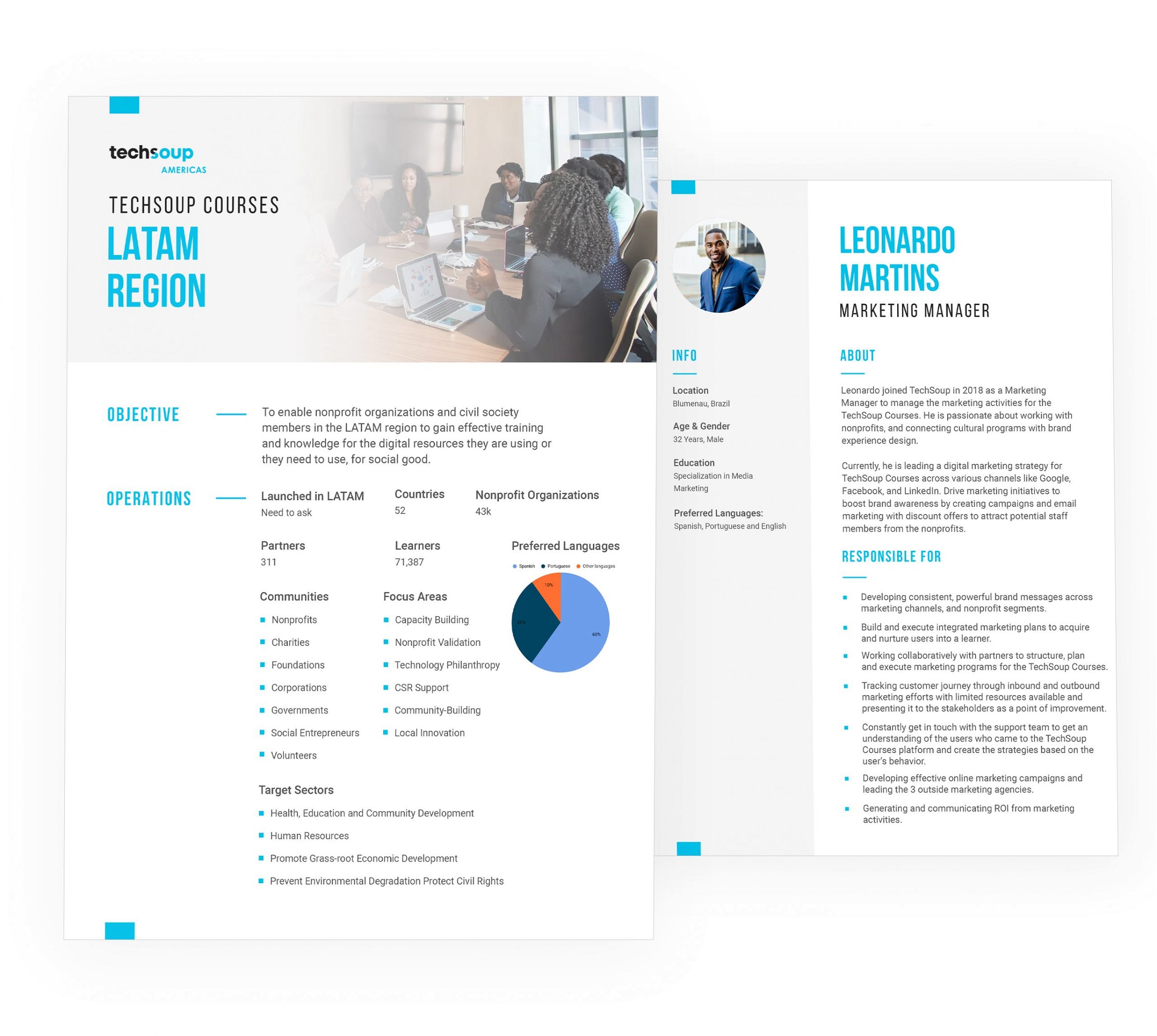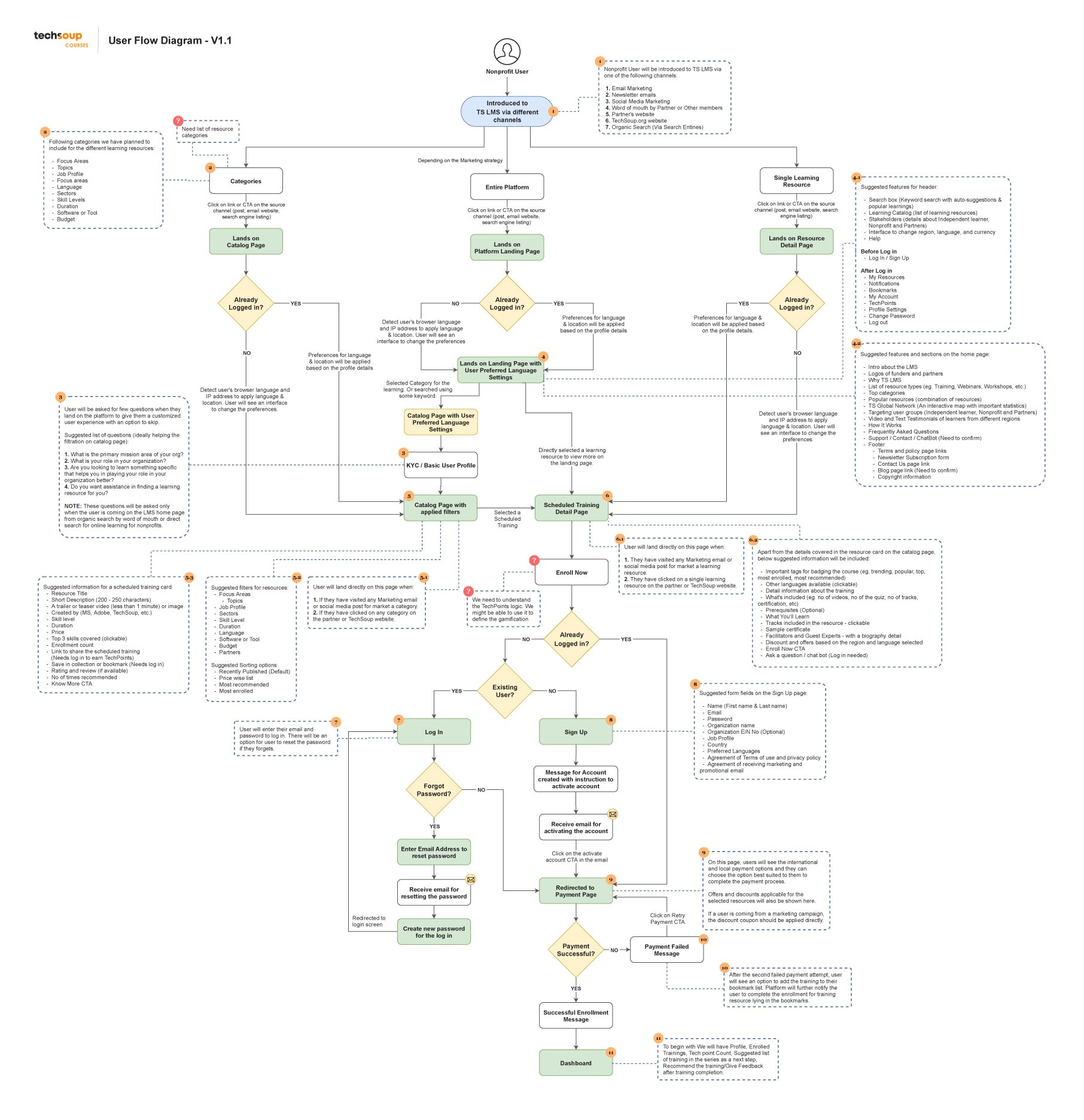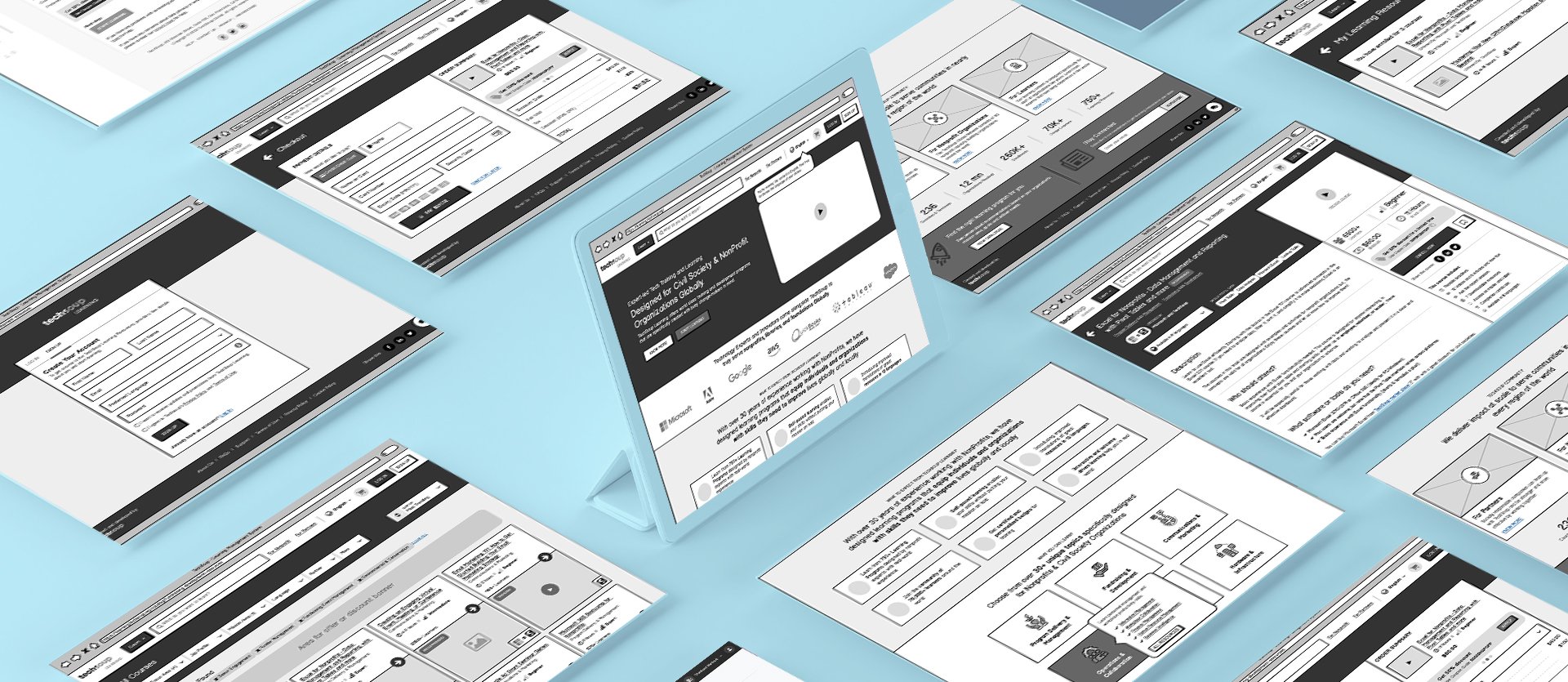How We Augmented TechSoup’s Existing LMS to Build a Highly Engaging Nonprofit Learning Platform
For Improved Learning Outcomes and Increased Global Reach
Project Scope
To redefine the User Experience and Design Intuitive Interface for TechSoup’s Learning Management System, used by a global audience of the non-profit sector.
Scale
236 Countries | 1.44 million Non-Profit Organizations | 9 languages
Duration:
Team:
1 Principal Designer
1 Product Designer
Introduction
In the year 2021, TechSoup – an end-to-end provider of technical support and technological tools to millions of nonprofits across the world – decided to replace its existing Learning Management System (LMS) with a new one based on Open edX.
Launched in February of the same year, TechSoup’s LMS needed a major overhaul both in terms of user experience and design, as well as the underlying feature engineering.
Earlier, Digicorp is currently developing a Digital Assessment Tool for TechSoup to help their nonprofit clients assess their current technology adoption landscape and unravel strategies and resources to step up the same. Having witnessed Digicorp’s unique and result-driven approach first-hand, the TechSoup team reached out to us in October 2021 to help them with their ensuing LMS project.
Problem Identification
Techsoup’s LMS module suffered from several challenges on the design and implementation front, which not only affected the learning outcomes of users but also prevented TechSoup from amplifying the global reach of their LMS tool by making it more intuitive and usable.
Based on:
- multiple discussions with the TechSoup team,
- in-depth focus group discussions with their users, and
- several one-on-one interviews with representative members of each user group,
Digicorp identified the key challenges to be resolved as well as the expectations of learners from the platform.
Below, we have cataloged the key challenges faced by users while using TechSoup’s LMS tool.
Challenges in Usability of TechSoup’s LMS Tool
User Onboarding
First-time Users: When users opened the LMS tool for the first time, they felt lost and confused. They found it especially difficult to access the right courses at the right time based on their needs.
Process Documentation: Many potential users were also confused about basic onboarding processes like how to register, or how to buy and access courses.
Cultural Barriers
UI Element for Choosing Language Options Was Not Accessible: TechSoup’s clients come from a wide range of geographies like countries in Latin America, Europe, and Africa where English is not necessarily the local language. Basic design errors like keeping the language selection option at the bottom of the page (where most users never bother to scroll down) made it difficult for them to onboard users.
Suboptimal UX for Implementing Language Preferences of Returning Users: Furthermore, selecting the language on one page did not automatically reflect the change across the entire website, causing frustration among users. Every time a user returned to the website, she/he had to reset her/his language preferences.
Look, Feel, and User Flow
The Design Elements Lacked Simplicity and Ease-of-Use: The vast majority of nonprofit users are hard-pressed to find the time or are fairly new to technology products. The overall design of TechSoup’s LMS tool was not addressing these guidelines. The platform lacked visual appeal and an intuitive experience.
A Logical Basis for Design Was Missing: Lack of basic design hygiene, coupled with suboptimal UI that caused important features to be hidden from clear sight, and the absence of a well-thought-out UX with a proper user flow made it difficult to acquire, engage, and retain users.
Content Challenges
Local Content Needs
Lack of Translations in Local Language: In some cases, the content was not available in the local language (like in the case of Brazil), causing more than 50% of the users to drop out as a result.
Mismatched Local Content Catalog: In other regions, like in the case of Kenya, the course catalog did not match the needs of the local nonprofit workforce. The strategies of nonprofit organizations in Kenya are distinctly different from those of Brazil or Spain. Hence, the content did not entice the local users in Kenya.
Underlying Content Structure
Lack of Emphasis on Benefits of the LMS Tool: The content was not structured in a way that communicated its value to the users. Most users found the free content to be too basic – something that would be easily available on other sites like YouTube, and hence, did not return to TechSoup LMS.
Users Were Unable to Make Informed Decisions on Paid Content: The paid content did not have a content summary or video to help users make an informed decision about purchasing the course. While the pricing was communicated, the value wasn’t. Hence, with the launch of paid courses in July 2021, the number of users dropped sharply.
Changes in Content Demand Post-pandemic Were Not Fully Addressed:After COVID-19 hit the world in 2020, the course requirements of organizations across the globe changed dramatically, including those of nonprofits.
Even though old challenges like fundraising and donations continued to be of interest to users, new topics like – managing organization data, working remotely, using remote communication tools within the organization, and cybersecurity – gained prominence.
However, the content structure did not reflect the same and hence, did not resonate with the users.
Product Challenges
TechSoup’s Freemium Model Required Some Modifications:
When compared with other competitors, TechSoup’s LMS tool did not have a robust paywall structure that worked in their favor. They needed a way to entice users with high-quality introductory content and then incentivize them to try out the more advanced content by paying for it.
Some Benefits Provided by Competitors Were Not There in TechSoup’s LMS Tool
Value-added offerings like user certification, dashboards, a wide range of pricing plans for individual and institutional users, and plans for onboarding non-unique users, were not available. Along the way, we also discovered that subscription plans needed to be introduced in some markets based on user expectations.
Collecting Payments Was Difficult and Prone to Technical Glitches
Unreliable payment gateways and offline payment processes in some regions made the payment collection process rather dicey. Furthermore, additional features were required for smooth payment processing, like validating the card details entered by the users to avoid fraud and providing alternative payment options to users in Brazil and Portuguese where issues with credit card failures are rampant.
Our Approach
Content and Meta-data Migration: For starters, Digicorp joined hands with TechSoup’s existing service provider (Raccoon Gang) to migrate all courses, assets, and user data to the new platform and re-work the UI-UX from scratch.
Stage-wise Deliverables: Post-migration, we shipped several interim deliverables based on project milestones like:
- user personas,

- detailed problem statements of different user groups,
- user flow diagrams,

- feature selection, and
- platform wireframes.
Platform Design Discovery: Digicorp has conducted in-depth Design Discovery for TechSoup’s LMS tool. Our team has conducted detailed domain and user research and created critical artifacts like personas, user flows, and wireframes.
Using lean-agile frameworks and design thinking, we expedited the Design Discovery process without compromising on the platform quality, efficiency, and effectiveness. An important aspect of our overall process was the selection of features and identifying the best ways and means to bring them to life. We have outlined the same below.
Feature Engineering for TechSoup LMS
Using a user journey focus, the key features embedded in the new platform were:
- Designing a highly appealing and enticing Home Page for better user onboarding.
- Easy-to-access registration page with clear account registration workflows.
- Login-logout workflows, SSO, Data export, and improved user session management.
- Automatic language translation with easy-to-access tools for setting language preferences.
- Better tracking system to see where learners are dropping out.
- Systematic content structuring with a clear course catalog, course summary, and features like intuitive course catalog layout, advanced search, easy filtering, and seamless course selection for improved user experience.
- Course cart checkout & payment features that addressed the payment regulations and processes in various countries, provided various easy-to-adopt payment plans to users based on their needs, reduced fraud, and made all transactions on the platform seamless.
- Upsell options like recommending related courses at the end of the purchase, and highlighting tailor-made offers like discounts and price drops.
- Improved marketing terminology for SEO by embedding search-friendly meta and keywords on the platform and enabling better visibility and discovery in channels like YouTube.
- Analytics-powered dashboard to review progress, identify gaps, and improve the learning outcomes of users, along with a review and rating feature post completion of the course.
- Quick and easy evaluation and certification to boost the morale and confidence of users.
- Easy help options on the platform with the ability to reach out to the TechSoup team in case of any technical difficulties faced by the user.
- Meticulous platform branding through appropriate color scheme, visual symmetry, flawless iconography, certificate design, adherence to Global Design Standards (like Right-to-Left vs. Left-to-Right orientation of text in languages such as Arabic or Hebrew), and adherence to Accessibility Standards for supporting differently abled users.

Conclusion
Offering learning resources to nonprofits is a critical element of TechSoup’s overall strategy toward supporting nonprofits and making them tech-enabled.
By drastically improving new user acquisition, overall user engagement, and long-term user retention, and by infusing synergy between TechSoup’s LMS tool and its other initiatives, Digicorp is pleased to have contributed to the exciting journey of TechSoup in empowering nonprofit organizations with the power of technology.
To give your organization the Digicorp advantage, get in touch with us today by clicking here Digicorp.
You can also explore our capabilities by visiting Digicorp or dive deeper into our projects, case studies, and client testimonials by visiting Digicorp.
For more success stories like this, don’t forget to subscribe to our blog! Digicorp